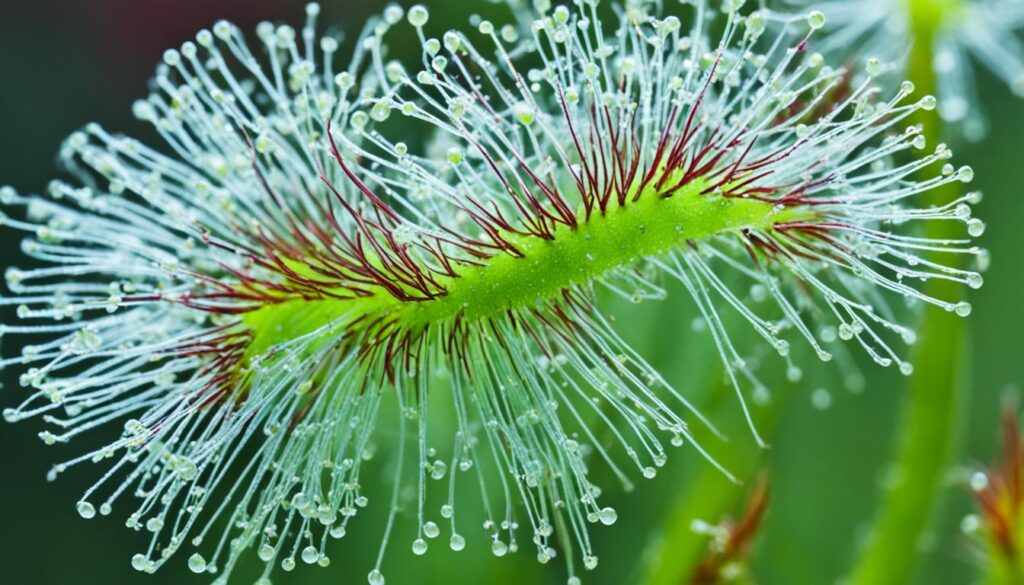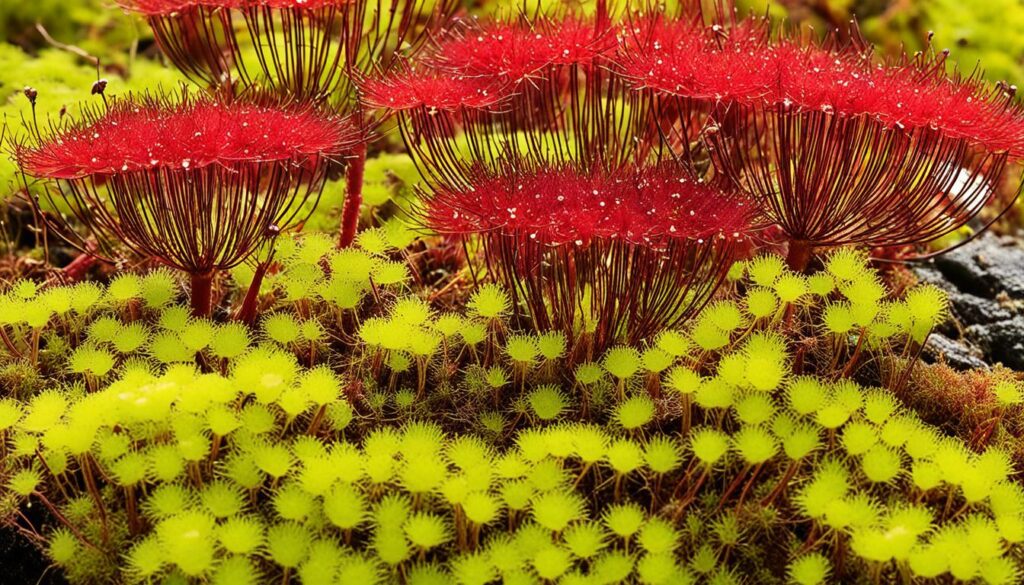Have you heard of the amazing Drosera glanduligera? This carnivorous plant is from southern Australia. It stands out with its pretty rosette shape, sticky leaves, and how it catches insects.
So, what’s its story, and how does it do so well where it’s from? Let’s discover the wonders of this Australian marvel together.
Introducing the Drosera glanduligera
The Drosera glanduligera, or Pimpernel Sundew, is a captivating carnivorous plant. It is found in the south regions of Australia. You can see it in places like southern Queensland, New South Wales, and more.
A Captivating Carnivorous Plant
The Drosera glanduligera is not your average plant. It belongs to a family of sundews. Despite its small size, with leaves typically 2.5 to 6 centimeters wide, it has amazing skills. Its leaves are shaped like a cup and covered in glandular hairs. This helps it catch its prey, making it stand out in the botanical world.
Endemic to Southern Australia
One cool thing about the Drosera glanduligera is that it only grows in the south of Australia. This means it is found nowhere else in the world. It can live in many different places in this area. From the coast, to the inland, it has found its home. It is in places like southern Queensland, New South Wales, and more.

This plant is a unique gem in the plant world of southern Australia. Exploring its special features shows us an amazing plant story. Its ability to grow in many places in this area makes it truly special.
Distribution and Habitat
The stunning Drosera glanduligera, known as the Scarlet Sundew, lives across southern Australia. It grows in various places, showing off Australia’s unique landscapes.
Widespread Across Southern Regions
This plant can be found in many southern Australian spots. It lives from the coast to the woods. It’s able to grow well in the soil that doesn’t have many nutrients.
In some places, the Scarlet Sundew is all over. There, it’s easy to spot among other plants. Its success in different places shows how tough it is.
Diverse Environments for Growth
- Heathlands: It loves living in the sandy, poor soils of the coast’s heathlands.
- Woodlands: You can also find it in the low-nutrient soils of the woodlands, increasing the places it can live.
- Other Low-Nutrient Areas: This plant can handle various low-nutrient spots. This makes it very adaptable and tough.
The Drosera glanduligera’s wide spread and liking for different places show how adaptable it is. It thrives in the special conditions in southern Australia.

Drosera glanduligera’s Unique Features
The Drosera glanduligera, or glandular sundew, stands out as a unique carnivorous plant. It’s small, only 15 to 20 centimeters wide. It has concave spathulate leaves that form a rosette.
These leaves are touch-sensitive and lined with glandular tentacles. This is a special trait of the Drosera glanduligera. In the middle of each leaf, it has sticky tentacles for catching prey. The leaf edges have fast-moving tentacles that snap shut, trapping insects.
| Unique Feature | Description |
|---|---|
| Concave Leaves | The spathulate leaves of Drosera glanduligera are concave, perfect for catching and keeping prey. |
| Glandular Tentacles | Every leaf has tentacles that react to touch, with sticky ones in the middle and snap-tentacles at the tips. |
| Snap-Tentacle Movement | The plant’s snap-tentacles can move at 75 milliseconds, a quick action for capturing food. |
These unique traits make the Drosera glanduligera an incredible plant among its carnivorous kind. It shows the awesome ways plants adapt to survive in South Australia.
The Prey-Trapping Mechanism
In southern Australia, you can find a fascinating plant called Drosera glanduligera. This carnivorous plant has a unique way to catch its food. It uses a mix of a sticky flypaper and snap traps. This method shows just how smart plants can be when trying to grab a meal.
Combining Flypaper and Snap Traps
Drosera glanduligera has sticky tentacles that work like flypaper in the center of its leaf. These tentacles catch bugs that come too close. The plant also has moving snap-tentacles at the leaf’s edge. If something touches them, they quickly fling the prey into the gluey center for a sure catch.
Remarkable Tentacle Movement
The way Drosera glanduligera’s snap-tentacles move is quite amazing. Scientists have found these tentacles can bend and grab prey incredibly fast. This lightning-fast action shows how well the plant is built to catch insects, pulling in plant lovers and researchers worldwide.
Drosera glanduligera’s mix of flypaper and snap traps is a big deal in the world of carnivorous plants. It helps the plant catch food better and maybe even larger bugs. This feature has drawn a lot of attention from those who study these strange, meat-eating plants.
Taxonomy and Nomenclature
The Drosera glanduligera is a fascinating member of the Drosera genus. It was first described in 1844 by botanist Johann Georg Christian Lehmann. This carnivorous plant has sparked many debates around its classification.
Historical Classification Journey
In 1848, Jules Émile Planchon singled out Drosera glanduligera. He placed it in the Coelophylla section, marked by its unique evolution. Different experts have since debated about its place in the subgenus Drosera or Ergaleium. This shows the ongoing discussion about where it fits in the Drosera genus.
The Drosera genus houses almost 200 individual species, making it one of the biggest groups of carnivorous plants. These plants, called sundews, attract, catch, and eat insects with their sticky glands. They live on every continent but Antarctica, proving their adaptability and wide reach.
The story of Drosera glanduligera in taxonomy highlights how scientists work to understand complex plants. As we learn more about classifying plants, the status of this unique sundew is still a major research and discussion point. The botanical community is still trying to figure it all out.
Cultivation Challenges
Growing the Drosera glanduligera is both rewarding and hard for plant lovers. This bug-eating plant comes from the South of Australia. It needs very special conditions to grow well.
Specific Growing Needs
Starting its seeds can be tough. These seeds need very specific temperatures to grow. Nights should be between 1–8°C (34–46°F). Days should be warmer, around 15–25°C (60–78°F). Scraping the seed coat can help them grow faster.
After the seeds sprout, the right environment is key. This plant grows in the winter and doesn’t live very long. It likes cool and humid places. So, keeping it chilly, between 8–12°C (46–54°F), is good for it.
The plants shouldn’t bloom too early. For flowers to come, temperatures must stay below 8°C (46°F) at night. This makes sure they grow big enough first.
Drosera glanduligera also needs to eat insects. Bigger plants eat small flies. But, the little ones prefer springtails. A bit of liquid fertilizer on their leaves can also help them get their nutrients.
Getting the right balance of heat, wetness, and food is key for these plants. It’s not easy, but the effort is worth it for plant fans.
Drosera glanduligera
The Drosera glanduligera, or glandular sundew, is a small carnivorous plant from southern Australia. It’s known for its striking features. These include its cone-like leaves with many small tentacles. The plant’s way of catching food mixes both a sticky surface and a fast-moving snap trap. Even though it’s hard to grow, plant lovers are captivated by its unique look and interesting ways.
This species of Drosera is common in the south of Australia. It can be found from Kalbarri in the north to Esperance in the southeast. It also appears in the Eastern States. However, growing it is a complex task. It needs special care and diet, making it quite challenging for gardeners.
D. glanduligera mostly eats ants. It grows quickly when it has plenty of these insects to feed on. Its trap works in an unusual way. It can snap shut in just 0.15 seconds, unlike many other Drosera plants. This quick reaction makes it very good at catching prey and growing fast.
| Characteristic | Drosera glanduligera |
|---|---|
| Snap-tentacle Length | 6.3±2.2 mm |
| Maximum Tentacle Head Velocity | 0.17 m/s |
| Maximum Tentacle Acceleration | 7.98 m/s^2 |
The Drosera glanduligera’s trap works in two steps. First, the trap’s tentacle snaps. Then, the prey is moved onto the leaf’s sticky center. Here, the prey is absorbed by glue-tentacles in about two minutes.
You can find D. glanduligera in various places around Melbourne. These include beautiful natural spots and parks. Some locations are the Cranbourne Botanical Gardens and the Mornington Peninsula. Also, check out the Grampians National Park and Brisbane Ranges National Park.
Even though D. glanduligera is found in many areas, it needs constant feeding. It targets insects and small creatures with its swift trap. For good health and growth, each leaf must catch prey often.
Evolutionary Adaptations
The Drosera glanduligera is a fascinating plant that eats insects. It lives in southern Australia where nutrients are scarce. This plant, by eating insects, gets the nitrogen and phosphorus it needs. That’s how it has been able to survive and spread in this region.
Insectivorous Lifestyle Benefits
The Drosera glanduligera’s meat-eating ways help it in many ways:
- It gets important nutrients from insects in places where food for plants is rare.
- Its use of these nutrients helps it grow better and faster.
- By eating bugs, it has been able to live in more varied places.
Fossils show that plants like the Drosera glanduligera started eating insects millions of years ago. They’ve developed cool ways to catch their prey, like sticky and fast traps. This history shows how good they’ve become at it.
| Evolutionary Adaptation | Description | Benefit |
|---|---|---|
| Insectivorous Lifestyle | The ability to capture and digest insects to supplement nutrient intake, particularly nitrogen and phosphorus. | Thriving in nutrient-poor environments, enhanced photosynthesis and growth, and diversification into various ecosystems. |
| Prey-Trapping Mechanisms | Sophisticated adaptations, such as the combination of flypaper and snap traps, to efficiently capture and digest prey. | Improved efficiency in obtaining essential nutrients, contributing to the plant’s overall fitness and survival. |
| Evolutionary History | Carnivory in the Caryophyllales order, including Drosera glanduligera, can be traced back to the late Cretaceous period, around 90 to 65 million years ago. | A long history of adaptation has allowed the development of specialized features and strategies, enabling the Drosera glanduligera to thrive in its environment. |
The Drosera glanduligera has evolved amazing adaptations to its environment. This has helped it not just live but also grow and spread in the tough lands of southern Australia.
Conservation Status
The Drosera glanduligera is marked as Least Concern by the IUCN Red List. This means it’s numerous in southern Australia, its home. Still, its status might change in some areas. Understanding exactly what it needs for conservation will also be crucial.
Found only in southern Australia, saving the Drosera glanduligera is important. This helps keep the region’s ecosystems diverse. Even though it’s not in immediate danger of dying out, efforts must continue. These include keeping an eye on it, plus working to protect it from threats like losing its home, the changing climate, and over-collection for gardens.
The IUCN report on the Drosera glanduligera is a good first step. But, we need to be always ready to act if its situation changes. By focusing on saving this special plant, we protect southern Australia’s unique nature.



